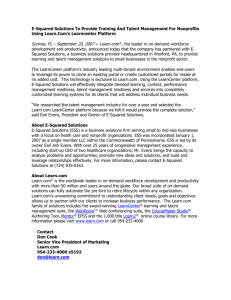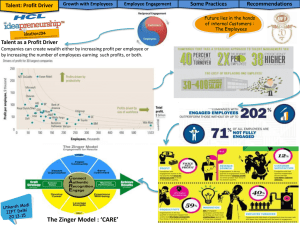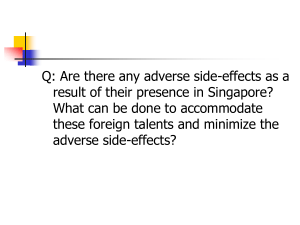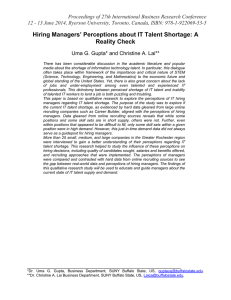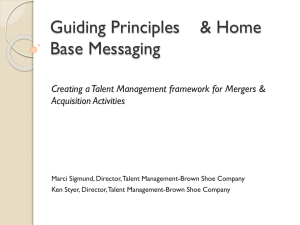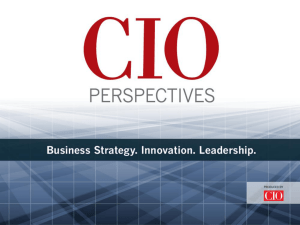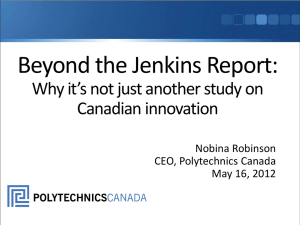Selected Studies on the ROI of Investments in
advertisement
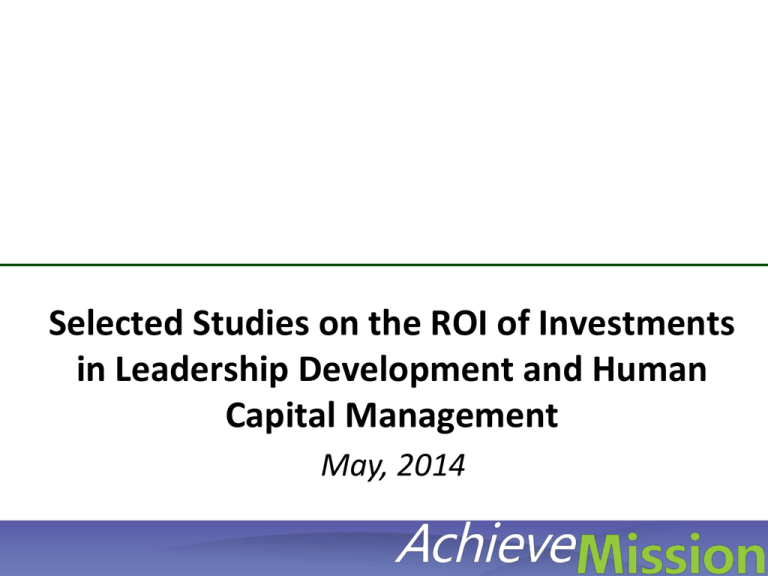
Selected Studies on the ROI of Investments in Leadership Development and Human Capital Management May, 2014 © AchieveMission 2012 Sample ROI Studies, Articles and Books • • • • • • • The Stanford Project on Emerging Companies, a longitudinal study of 200 Silicon Valley start-ups, found that only 7% had the type of formal HR department and practices seen at typical companies, but those with such capabilities were 40% less likely to fail and 40 percent more likely to go public. “…it turns out that organization building is not a secondary diversion from the ‘real’ work of launching a high-tech startup” the authors wrote. “It might well be the main event.” (James Baron and Michael Hannan, 2014, California Management Review) This study examines the effects of particular human resource management practices on the performance of small businesses – which may be particularly germane for the nonprofit sector -- and finds that certain ones are positively related to revenue growth and perceptions of performance. (Human Resource Management, Employee Exchange Relationships, and Performance in Small Businesses; Mathew R. Allen, Jeff Ericksen and Christopher J. Collins, 2013, Hum. Resour. Manage., 52: 153–173) Huselid’s (1995) groundbreaking study demonstrated that a set of HR practices he referred to as High Performance Work Systems (HPWS) were related to turnover, accounting profits, and firm market value. “Based on four national surveys and observations on more that 2,000 firms, our judgment is that the effect of a one standard deviation change in the HR system is 10-20% of a firm’s market value” (Huselid & Becker, 2000; p. 851) Intangible human capital assets, such the ability to attract and retain talent employees and the ability to understand and flexibly adapt to changes in the environment, are increasingly important to the way that markets value companies. Thus stronger human capital assets correlate with higher stock prices. (Dave Ulrich and Norm Smallwood, Why the Bottom Line Isn’t, 2003.) In a study of 590 for profit and nonprofit firms, there was a positive correlation between effective human capital management practices and staff perceptions of performance. Other studies have demonstrated a strong correlation between staff perceptions of and other more objective measures of performance. (The Impact of Human Resource Management Practices on Perceptions of Organizational Performance, John Delaney and Mark Huselid, Academy of Management Journal, 1996, Volume 39, No 4, 949-969) Companies with higher human capital management maturity levels produce higher revenue per employee (Bersin & Associates, various) © 2014 AchieveMission 2 Sample ROI Studies, Articles and Books p2 • • • • • • • • Institutions with stronger human capital management and leadership development practices produce a range of positive results including: higher math scores in schools, higher revenues per employee, and higher total stock returns. (Maximizing Your Return on People, March 2007, Harvard Business Review) Companies with high HCM maturity levels produced total returns to shareholders 50% greater than those with medium levels and 200% greater than those with low levels. (Watson Wyatt Human Capital Index Report 2001 & 2005) Best Places to Work companies outperformed the S&P 500 by more than 10x in the period 2001 to 2011. (BCG, From Capability to Profitability, 2012) Organizations that apply talent management best practices demonstrate higher financial performance compared to their peers (IBM/HCI, 2008) Strong human capital management capabilities predict strong financial results, and strong financial results predict strong human capital management capabilities. But the former is more than twice as strong. (Watson Wyatt Human Capital Index, 2001) A 2009 study by the Hackett Group found companies with more mature talent management capabilities post 18 percent higher earnings than typical Global 1000 companies. Hewitt Associates reports that the vast majority of top financial performing companies (85 percent of the top 20 in a field of 373 companies) hold their leaders accountable for developing talent, compared to just 46 percent of leaders from the other organizations…. How the top 20 companies grow great leaders. (Lincolnshire,IL: Hewitt Associates, 2005) DDI’s Leadership Forecast 2005–2006 showed that companies with stronger leadership development systems enjoy higher returns on equity and profit when compared to their competitors. (Bernthal, P., & Wellins, R., 2005) © 2014 AchieveMission 3 About AchieveMission Who We Are AchieveMission empowers nonprofit organizations to scale and sustain their impact by strengthening leadership and human capital management capabilities Human Capital Management Areas of Expertise Human Capital Management Strategy & Governance workforce planning, competencies, metrics, board’s role in governance Stronger Leadership & Team succession, Alignment & Accountability goal leadership & professional development, talent assessments, HIPO program management, performance management, balanced scorecards Optimized Performance organizational structure, internal communications, culture, decision-making Highly Capable Talent Department capabilities, staffing levels, roles Services Talent Initiative program Custom Consulting & Advisory © 2014 AchieveMission 4
